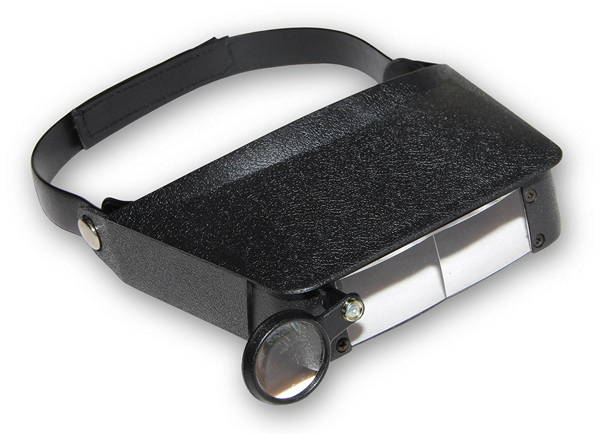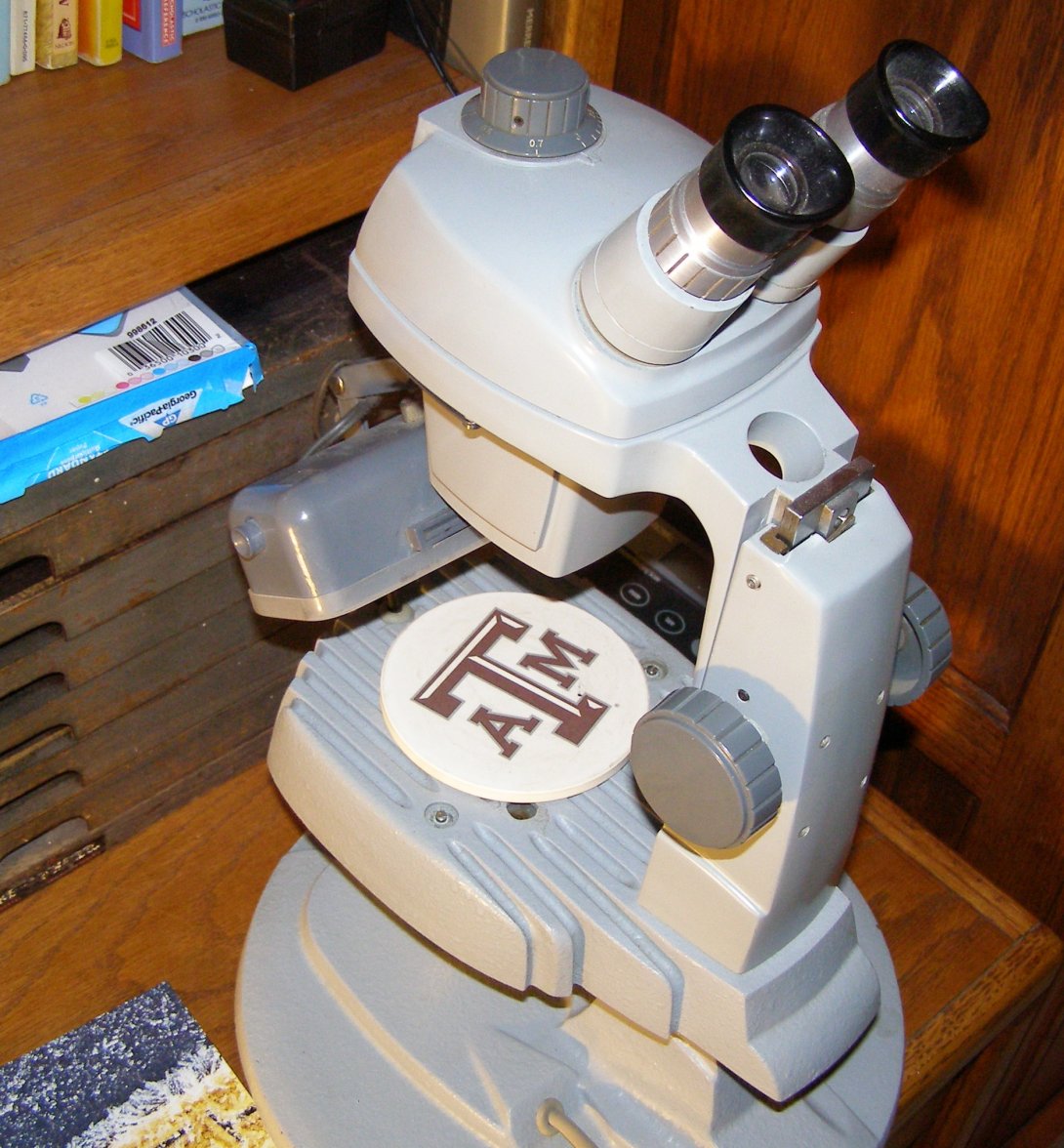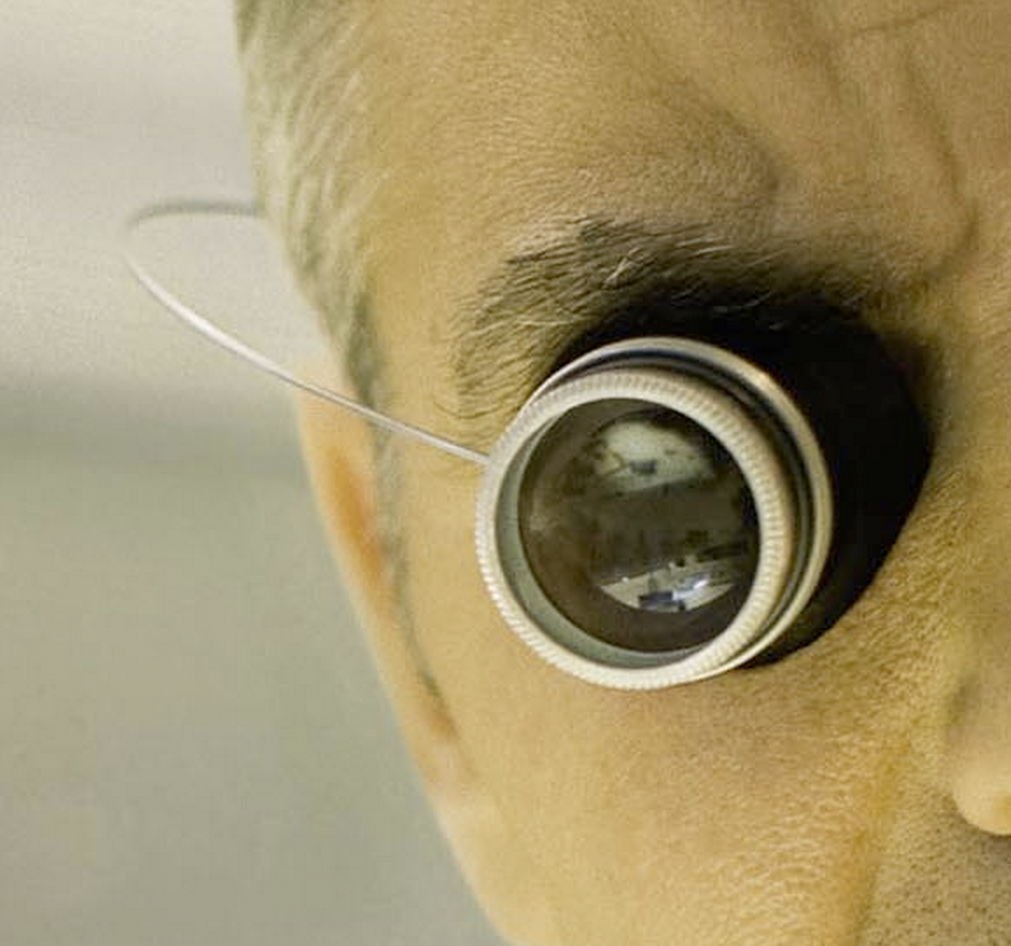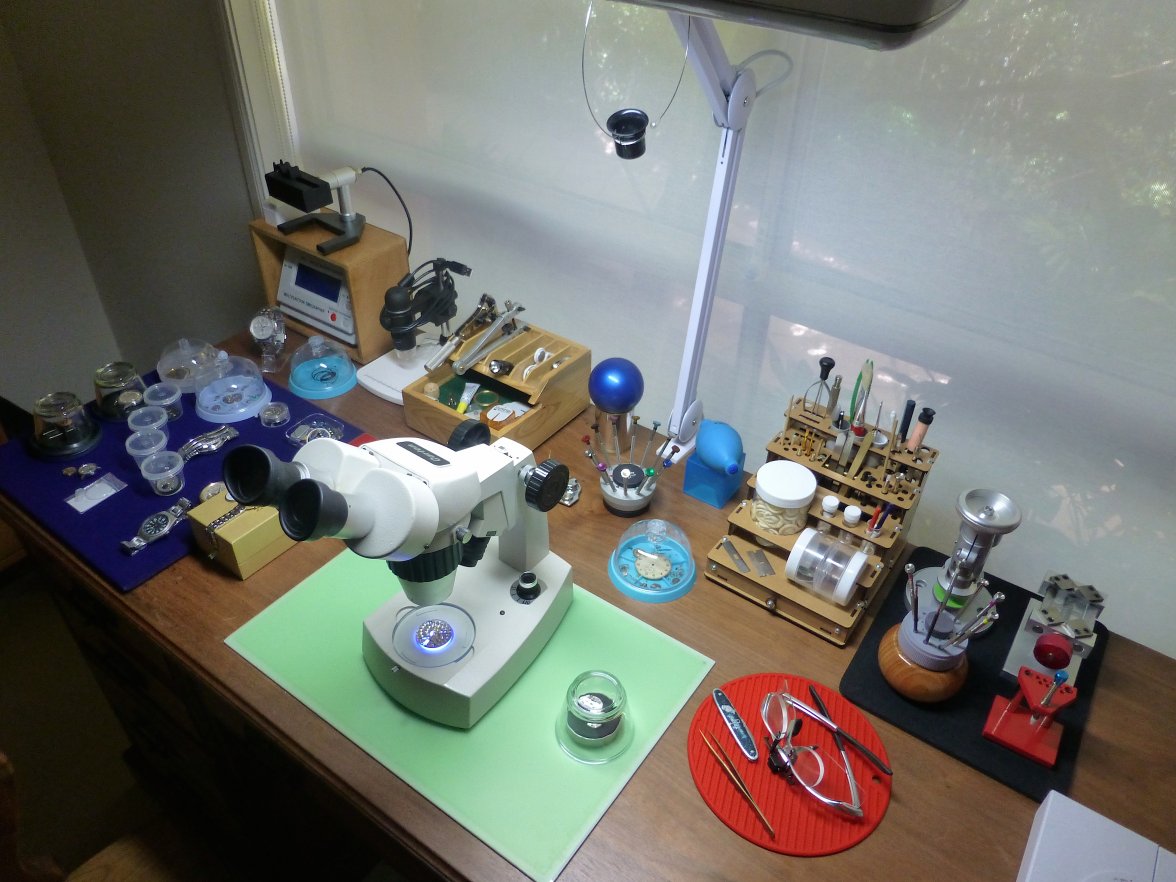Loupe power
speedbird
·Looking at your watch under a loupe is like looking at your face in a truck stop bathroom, under fluorescent lights, at 2am. You're going to see flaws you don't even have yet.
No loupe, no problems
No loupe, no problems
Archer
··Omega Qualified WatchmakerFirst for normal assembly work, I use a 4X loupe that is a flip down lens on my reading glasses. For most finer tasks, I use a 10X eye loupe on a wire that wraps around my head, and for very detailed work, I use this:

I replied to the post above showing the view through the loupe as it shows the big problem with cheap loupes - spherical aberration. You can see that the center of the viewing area is very clear, but the outside edge is distorted. This will cause eye fatigue and headaches when using a loupe for a longer period of time. An aplanatic loupe will be as clear on the edges of the field as it is in the middle, and will greatly reduce eye strain and fatigue.
Cheers, Al
- Posts
- 25,980
- Likes
- 27,649
ulackfocus
·I replied to the post above showing the view through the loupe as it shows the big problem with cheap loupes - spherical aberration. You can see that the center of the viewing area is very clear, but the outside edge is distorted. This will cause eye fatigue and headaches when using a loupe for a longer period of time. An aplanatic loupe will be as clear on the edges of the field as it is in the middle, and will greatly reduce eye strain and fatigue.
Cheers, Al
This is great info. 👍
TNTwatch
·At first, I tried to save with a set of 4 Indian aluminium loupes, but the quality was so low so I switch to a B&L 5x which has good quality but the power is actually 6x. Then I happened on a pair of stereo head loupe with 2.2x, 3.3x and 5.2x and pretty good quality, similar to the B&L. It's exactly like this one: http://www.peakoptics.com/index.php?main_page=product_info&products_id=100. There are better stuff out there but I haven't found the need yet. Now I wouldn't go back to single eye loupe, except for inspecting for which I've also got the Belomo 15x. I haven't found any eye fatigue since I mostly just look at the center of the field and move the center of the loupe to where I need to look at. I'll check it out again but my impression is its quality is certainly good enough for eye-balling small details, not too far behind my Nikon 50mm f1.4 lens used in reverse - which was my inspecting loupe before I got any loupes.
Edited:
Archer
··Omega Qualified WatchmakerIf all you are doing is looking at your watches for short periods of time, then cheap loupes like the Optivisor style are fine (no professional I know uses such a set-up). This is quite a different sort of application than sitting a bench for 8 hours actually working on watches. When working for long periods on fine details, clarity is extremely important - and I only really noticed the difference when I upgraded loupes.
For me, my eyes are well worth the extra money spent.
Cheers, Al
For me, my eyes are well worth the extra money spent.
Cheers, Al
TNTwatch
·Al, you don't have to buy cheap one if you're so inclined: http://www.zeiss.com/vision-care/en...rofessional-users/head-worn-loupes-kf-ks.html. The keyword is stereo, which is night and day different in terms of relaxing your eyes. While many pro use the single eye loupe, I'd actually seen 2 watchmakers in the GTA area wearing these kind of visors before I realized what they were.
BTW, what brand is your 4x eye loupe?
Regards,
Tony
PS: I do have multiple versions of Zeiss and Nikon 50mm SLR lenses so I think I recognize good clarity when I see it.
BTW, what brand is your 4x eye loupe?
Regards,
Tony
PS: I do have multiple versions of Zeiss and Nikon 50mm SLR lenses so I think I recognize good clarity when I see it.
Edited:
Archer
··Omega Qualified WatchmakerAs I said, no professional I know uses this kind of set-up. Certainly some may use it, but none of the watchmakers I've ever interacted with have. These seem very popular with hobbyists because they don't have the experience needed to use magnification in one eye and be able to estimate depth, so they need to use both eyes. Most professionals have no problems with doing work just using one eye with magnification. BTW using one eye doesn't mean you have the other one closed, which I agree causes more strain - I always have both eyes open when I work...no strain.
My 4X loupe is a Behr loupe.
Cheers, Al
My 4X loupe is a Behr loupe.
Cheers, Al
woodwkr2
·In loupes, a Bausch and Lomb is entry level. Asco is commonly used and is a step up in price with decent optics. Indeed, for most people, Asco may hit the ideal cost to quality ratio. If you want to go nicer, there are some nice German brands such as Sternkreuz and Eschenbach that are fairly reasonable... or skip them and go straight to the Mercedes: Petitpierre. Do not waste your time on the cheap stuff, there's just too big a difference.
I've actually got a set of the PP loupes incoming. I went with 2.5x and 5x. Completely ridiculous use of funds, but I got sick of searching for reviews and reading, reading, reading. After reading several watchmaker reviews of the PP loupes (and a couple glasses of bourbon), I just pulled the trigger. I've got a vintage B&L 10x with incredible optics that I use for very fine work.
Remember that optical quality and focal length are more important attributes for a loupe than simple magnification power. With the nicer optics, you may find that lower magnification power is required for the same field of view compared to the cheaper stuff.
When the PP set arrives, remind me and I'll post a review.
Your most important decision will depend on whether you wear eyeglasses or not. For eyeglass wearers, there are flip downs like Al mentioned. I've owned a set of Bergeon/Ary ones that were decent. Definitely a step up from B&L, but not as nice as Asco.
For the non-eye glass wearers, I'd strongly encourage you to skip all the ridiculous head gear and go old school. Get a watchmaker style loupe with a spring band and get comfortable wearing and using it. If you're going to spend enough time around watches that magnification is needed, learn how to do it properly.
I've actually got a set of the PP loupes incoming. I went with 2.5x and 5x. Completely ridiculous use of funds, but I got sick of searching for reviews and reading, reading, reading. After reading several watchmaker reviews of the PP loupes (and a couple glasses of bourbon), I just pulled the trigger. I've got a vintage B&L 10x with incredible optics that I use for very fine work.
Remember that optical quality and focal length are more important attributes for a loupe than simple magnification power. With the nicer optics, you may find that lower magnification power is required for the same field of view compared to the cheaper stuff.
When the PP set arrives, remind me and I'll post a review.
Your most important decision will depend on whether you wear eyeglasses or not. For eyeglass wearers, there are flip downs like Al mentioned. I've owned a set of Bergeon/Ary ones that were decent. Definitely a step up from B&L, but not as nice as Asco.
For the non-eye glass wearers, I'd strongly encourage you to skip all the ridiculous head gear and go old school. Get a watchmaker style loupe with a spring band and get comfortable wearing and using it. If you're going to spend enough time around watches that magnification is needed, learn how to do it properly.
Edited:
TNTwatch
·There seems to be some bias against stereo eye loupes here, which I don't think there's a good reason for. I understand that there's no question that pros are better than armatures, one eye or both. But there's no question that estimating depth with both eyes are better than just one eye, so if someone is good with one eye, then with both eye they wouldn't be worse off. Just like there are good one-eye loupes, there are also good stereo loupes, for example those used in medical surgery surely are. While not many watchmakers use the stereo kind, I don't think any surgeons use the one-eye loupe at all.
Also focal length and magnification power are directly related to each other, so it's mistaken to say one is more important than the other.
Also focal length and magnification power are directly related to each other, so it's mistaken to say one is more important than the other.
woodwkr2
·There seems to be some bias against stereo eye loupes here, which I don't think there's a good reason for. I understand that there's no question that pros are better than armatures, one eye or both. But there's no question that estimating depth with both eyes are better than just one eye, so if someone is good with one eye, then with both eye they wouldn't be worse off. Just like there are good one-eye loupes, there are also good stereo loupes, for example those used in medical surgery surely are. While not many watchmakers use the stereo kind, I don't think any surgeons use the one-eye loupe at all.
Also focal length and magnification power are directly related to each other, so it's mistaken to say one is more important than the other.
Actually many watchmakers working in Swiss factories use stereo eye loupes similar to the type that surgeons use. The advantage of these optics lies in the long working distance, which is a necessity for surgeons and a luxury for watchmakers. It's also important to note that custom made stereo eye loupes run about 1-1.5k for a set. That's fine when Patek is footing the bill, but you'll be hard pressed to find an independent who's willing to shell out that kind of money, especially when they've trained with the monocular style and have become quite adept with it. There's no one-size-fits-all answer here. It's training, personal preference, and budget.
It also has to do with intended usage. The cyborg/optivisor style that you like is much more commonly used in the jewelry making trade where it offers a little more eye protection when using a hand piece (pro Dremel) and abrasive disc. Clockmakers, for whatever reason, also seem to like that style. But if you show up at any watch or watchmaking event in one of those things... well, that'd be pretty funny, actually 😎. Most jewelers who are dealing in fine stones use a hand held triplet. And if you're looking for something to take with you to the flea market, that's likely your best bet.
Yes, focal length and magnification power are directly related to each other. The laws of physics ultimately prevail in any discussion of optics. I guess I wasn't clear in my explanation. Stated magnification isn't always standard. One brand of loupes marked 4x may be quite different than another brand of loupes marked 4x. Yes, magnification matters; a 10x loupe will be much better suited for certain tasks than a 4x loupe. But beyond those gross distinctions, optical quality and focal length are far more important considerations than getting hung up on whether to select a 4x vs. 5x loupe.
Indeed, if you look at the Asco loupes for example, they are marked by focal length not magnification. The Asco 2.5 loupe is the most widely used in watchmaking. It's marked on the barrel 2 1/2. It's a 4x loupe.
Edited:
redpcar
·
Are you wanting to repair watches or examine them? Repair, you will need something like what George Clooney is wearing in my previous post. My idea of a triplet is this. Great for observing. Not good for repair. I have Bausch & Lomb and Asco. Both very nice. I also have some cheapies (sub $5 each) that work just fine. Not as clear but will work for hobby repairs. If you do it every day all day, you would want the best. Have you ever asked a hair stylist how much they paid for their scissors? Or a mechanic with his wrenches? A good place to go is casker.com or julesborel.com. You will get a good idea of average loupes. $15 to $50
redpcar
·First for normal assembly work, I use a 4X loupe that is a flip down lens on my reading glasses. For most finer tasks, I use a 10X eye loupe on a wire that wraps around my head, and for very detailed work, I use this:
I replied to the post above showing the view through the loupe as it shows the big problem with cheap loupes - spherical aberration. You can see that the center of the viewing area is very clear, but the outside edge is distorted. This will cause eye fatigue and headaches when using a loupe for a longer period of time. An aplanatic loupe will be as clear on the edges of the field as it is in the middle, and will greatly reduce eye strain and fatigue.
Cheers, Al
woodwkr2
·TNTwatch
·Are you wanting to repair watches or examine them? Repair, you will need something like what George Clooney is wearing in my previous post. My idea of a triplet is this. Great for observing. Not good for repair. I have Bausch & Lomb and Asco. Both very nice. I also have some cheapies (sub $5 each) that work just fine. Not as clear but will work for hobby repairs. If you do it every day all day, you would want the best. Have you ever asked a hair stylist how much they paid for their scissors? Or a mechanic with his wrenches? A good place to go is casker.com or julesborel.com. You will get a good idea of average loupes. $15 to $50
woodwkr2
·JimInOz
··Melbourne AustraliaNICE!!!! Here's my 1970's version. My best single purchase I have ever made. It matches all my groovy vintage watches well 😉. Maybe we should start a thread of "Show me your scopes"
Okay Aggie, here's mine.
I use a triplet for just looking at stuff, dual magnifier clip-on for general work, a springy loupe for close work and the scope for oiling etc.
redpcar
·Okay Aggie, here's mine.
I use a triplet for just looking at stuff, dual magnifier clip-on for general work, a springy loupe for close work and the scope for oiling etc.






